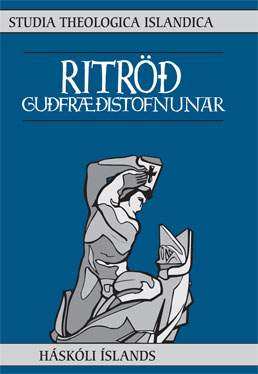Stefnumót við brennuvarg hjartans
Emmaus-gangan og guðsþjónusta þjóðkirkjunnar
Lykilorð:
Litúrgísk guðfræði, guðsþjónustan, Handbókin, uppbygging messunnar, tengsl menningar og helgihalds, nýsköpun í helgihaldi, Emmaus-frásögnin, Liturgical theology, (components of the) Sunday service, worship and culture, worship and innovation, the Emmaus narrativeÚtdráttur
Útdráttur
Í greininni er rakin frásögn Lúkasarguðspjalls (24.13–35) af för tveggja lærisveina Jesú til Emmaus og móti þeirra við óþekktan samferðamann sem reynist hinn upprisni Kristur og frásögnin borin saman við guðsþjónustu íslensku þjóðkirkjunnar eins og hana er að finna í gildandi helgisiðabók (Handbók). Sérhverjum hinna fjögurra meginþátta messunnar, þ.e. messuupphafi, þjónustu Orðsins, samfélagi altarisgöngunnar og messulokum, er hér lyft að ljósi og því haldið fram að finna megi samsvörun við hvern þeirra í fjórum hlutum Emmaus-frásagnarinnar. Samanburðurinn sé til hvors tveggja fallinn: að dýpka skilning á andlegri merkingu og tilgangi messunnar og að leggja grunn að áframhaldandi nýsköpun í helgi-þjónustunni, þar sem ný messuform geti byggst á grundvelli „Emmaus-módelsins“. Í greinarlok eru nefnd dæmi um slíka nýsköpun í samhengi við módelið og settar fram spurn-ingar um tengsl menningar og helgihalds.
Abstract
This article compares Luke’s narrative (24.13-35) of the two disciples on the road to Emmaus, and their companionship with the risen Christ in the guise of a stranger, with the Sunday service of the Evangelical Lutheran Church of Iceland, as it is prescribed in ELCI´s current Worship Book (Handbók). Reflecting on the four building blocks of the service (Gathering, Service of the Word, Service of the Table, Sending), the article claims that they can be compared and correlated with the four main parts of the Emmaus narrative. The comparison serves a twofold purpose: a deeper understanding of the spiritual meaning and goal of Sunday worship, and supporting an ongoing innovation in the church, where the “Emmaus-paradigm” might be a guidance for creating new forms and texts for worship. Examples of innovation are cited and correlated with the paradigm, and with questions regarding the dynamics between liturgy and culture.


